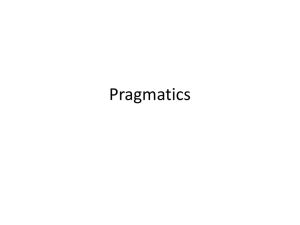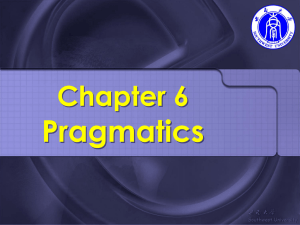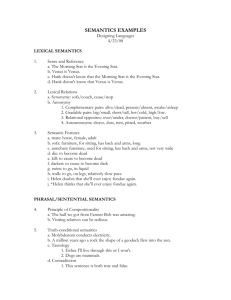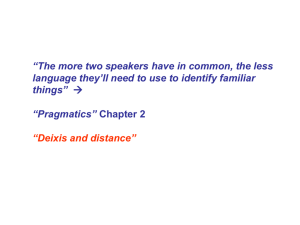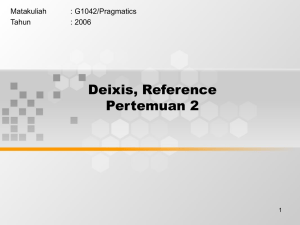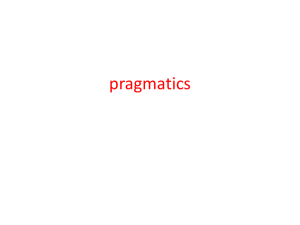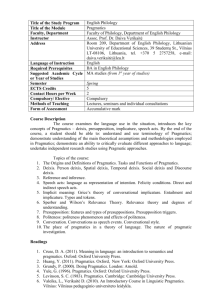pragmatics-summary
advertisement
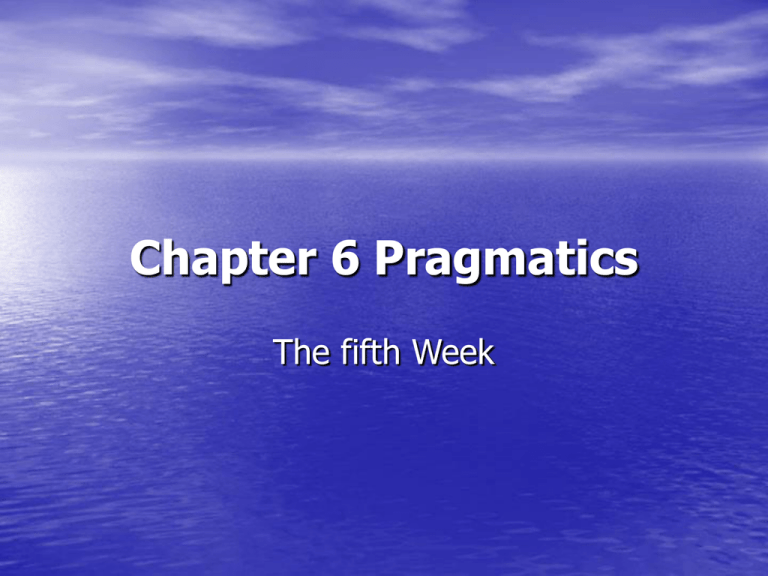
Chapter 6 Pragmatics The fifth Week Key points • The definition of pragmatics • Micropragmatics difficulties • Reference • Deixis • Anaphora • presuppostion 6.1 Introduction • Pragmatics is the study of the relationships between linguistic forms and the users of those forms. In this threepart distinction, only pragmatics allows humans into the analysis. • The natural realization is that grammatical analysis alone is not enough. The difference between grammatical analysis and pragmatic analysis • First, grammatical studies look for rules while pragmatic studies look for principles. Rules are black and white, i.e. you are either right or wrong. For instance, you have to say “He studies linguistics”; the –s is required by a rule. Principles are not black and white; you can obey them to some extent and violate them to some extent. For example, one principle says we should tell the truth and another says we should be polite in our speech. • Secondly, in grammar studies, we end up with products while in pragmatics we always deal with processes. In other words, after we have analyzed a sentence grammatically, our job is done; in a pragmatic inquiry, we deal with an ever-unfolding process-as the discourse goes on and on, the extra meaning of some words become clearer and clearer. 6.2 Micropragmatics • Phenomena such as reference, deixis, anaphora and presupposition, are the topics in this field. Definition of macropragmatics • The studies look deep into the mechanisms by which speakers writers encode their message in skillful ways and how hearers\readers arrive at the intended meanings in spite of the differences between the literal meaning and the intended meaning. This approach of study is called macropragmatics. 6.2.1 Reference • Words themselves don’t refer to anything, people refer. Reference is thought as an act in which a speaker, or writer, uses linguistic forms to enable a listener, or reader, to identify something. The categories of referring expressions • • • Referring expressions • (1) proper nouns (2) definite nouns (3) indefinite nouns (4) pronouns Three-dimensional diagram • Speakers------ reference------ intention • Listeners------ inference------ interpretation • Sense---reference---referent • Word---meaning---entity The examples of inference • (1) a. Where is the fresh salad sitting? • b. He’s sitting by the door. • (2) a. Can I look at your Shakespeare? • b. Sure, it’s on the shelf over there. Logical understanding between reference and inference • These examples make it clear that we can use names associated with things (salad) to refer to people and names of people (Shakespeare) to refer to things. The key process here is called inference. An inference is any additional information used by the hearer to connect what is said to what must be meant. In example (2), the hearer has to infer that the name of the writer of a book can be used to identify a book by that writer. In pragmatics, the act by which a speaker or writer uses language to enable a hearer or reader to identify something is called reference. Referential and attributive uses • 60年代,Donnellan 在其名作《指称与确定性描 • 述语》中提出确定性描述语同时具有两种不同的 用法,即归属性用法(attributive use)和指称性用法 (referential use)。 做指称性使用时,说话人用确定性描述语这一方 式来指称某一个特定的人或物,而确定性描述语 作归属性使用时,说话人是在把某种特性或属性 归诸某个符合该确定性描述语的人或物,描述此 人或物是如此这般的。 Examples of referential and attributive uses • a. There’s a man waiting for you. • b. He wants to marry a woman with lots of money. 6.2.2 Deixis • Deixis means “pointing via language”. Any linguistic form used to do this “pointing” is called a deictic expression. Words like here, there, this, that, now and then, as well as most pronouns, such as I, we, you, he, her and them are deictic expressions. Deictic center: the time of the utterance’s time; the place of the utterance’s place, the person just giving the utterance . • “Near speaker” —“away from speaker” • ︱ • Proximal • ︱ • This, here, now ︱ distal ︱ that, there, then (1) You’ll have to bring that back tomorrow, because they aren’t here now. • Our of context, we cannot understand this sentence because it contains a number of expressions such as you, that, tomorrow, they, here and now which depend for their interpretation on the immediate physical context in which they were uttered. Classification of deixis • • • Deixis: • • person deixis Spatial deixis Temporal deixis Discourse deixis Social deixis} Five types of deixis. • (1) Person deixis: Any expression used to point to a • • • • person: me, you, him and them. (2) Time deixis: words used to point to a time: now, then, tonight, last week and this year… (3) Space/spatial/place deixis: words used to point to a location: here, there and yonder (4) Discourse deixis: any expression used to refer to earlier or forthcoming segments of the discourse: in the previous/next paragraph, or Have you heard this joke? (5) Social deixis: honorifics (forms to show respect such as Professor Li) 6.2.3 Anaphora (照应、回指) (Anaphoric reference) • In most of our talk and writing, we have to keep track of who or what we are talking about for more than one sentence at a time, we use anaphoric reference. (1) A: Can I borrow your dictionary? B: Yean, it’s on the table. • Here, word it refers back to the word dictionary. The previous word dictionary is called the antecedent (先行语), and the second word it is called the anaphor(回 指语)or anaphoric expression. Anaphor and antecedent • In English, initial reference,, or introductory mention, is often indefinite (a man, a woman, a cat). In the example the definite noun phrases (the man, the cat, the woman) and the pronouns (it, he, her, they) are examples of subsequent reference to already introduced referents, generally known as anaphoric reference, or anaphora. In technical terms, the second or subsequent expression is the anaphor and the initial expression is the antecedent. Cataphora • Cataphora: I turned the corner and almost stepped on it. There was a large snake in the middle of the path. Zero anaphora, or ellipsis • Cook for three minutes. Indirect anaphora or bridging reference • (2) I walked into the room. The windows looked out to the bay. • • • • ︱ Antecedent ︱ anaphor ︱ Indirect anaphora or bridging reference 6.2.4 Presupposition • A presupposition is something the speaker assumes to be the case prior to making an utterance, symbolized by >>. Speakers, not sentences, have presuppositions. presupposition triggers • In any language, there are some expressions or constructions which can act as the sources pf presuppositions. This kind of expressions or constructions is called presupposition triggers. The following are some examples, where the presupposition triggers themselves are italicized • • • • • • • • • • • • • • • (1) Definitive descriptions John saw the man with two heads >> There exists a man with two heads. (2) Factive verbs John realized that he was in debt >> John was in debt. (3) Change of state verbs Joan began to beat her husband >> Joan hadn’t been beating her husband. (4) Iteratives The flying saucer came again >> The flying saucer came before. (5) Temporal clauses While Chomsky was revolutionizing linguistics, the rest of social science was asleep >> Chomsky was revolutionizing linguistics. (6) Cleft sentences It was Henry that kissed Rosie >> Someone kissed Rosie. (7) Comparisons and contrasts Carol is a better linguist than Barbara >> Barbara is a linguist. The negative form of the above sentences has the same presupposition. Assignments • • • • • • • • • • • I. Define the following terms briefly: (1) pragmatics (2) deixis (3) reference (4) anaphora (5) presupposition II. What are the deictic expressions in the following utterance? I’m busy now so you can’t do that here. Come back tomorrow. III. What are the anaphoric expressions in the following utterance? Dr. Dang gave Jane some medicine after she asked him for it. IV. What is one obvious presupposition of a speaker who says: (1) Where did he buy the beer? (2) Your watch is broken. (3) We regret buying that car.
